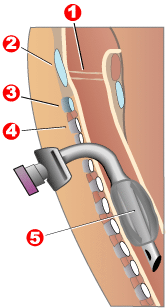
Photo from wikipedia
Objective: To determine the risk factors for the need of tracheostomy after cervical spinal cord injury (CSCI) at the acute stage. Methods: The authors retrospectively reviewed 294 patients with acute… Click to show full abstract
Objective: To determine the risk factors for the need of tracheostomy after cervical spinal cord injury (CSCI) at the acute stage. Methods: The authors retrospectively reviewed 294 patients with acute traumatic CSCI in Xinqiao Hospital between 2012 and 2016 and analyzed the factors postulated to increase the risk for tracheostomy, including patient’s age, neurological impairment scale grade and level, smoking history, combined injury, and surgical intervention. Logistic regression analysis was used to identify independent risk factor for the need of tracheostomy. Results: Of 294 patients, 52 patients received tracheostomy (17.7%). The factor identified by demographics and outcomes were smoking history, cause of injury, neurological impairment scale grade and level, and combined dislocation. A multiple logistic regression model demonstrated that age of 60 years older, combined facet dislocation, C4 level high, and the American Spinal Injury Association (ASIA) A and B scale were predictive of need for tracheostomy on 95% occasions. Conclusion: The high age of 60 years, combined facet dislocation, C4 level high, and ASIA A and B scale are indispensable to predict the need for tracheostomy in patients with CSCI at the acute stage.
Journal Title: Journal of Orthopaedic Surgery
Year Published: 2019
Link to full text (if available)
Share on Social Media: Sign Up to like & get
recommendations!